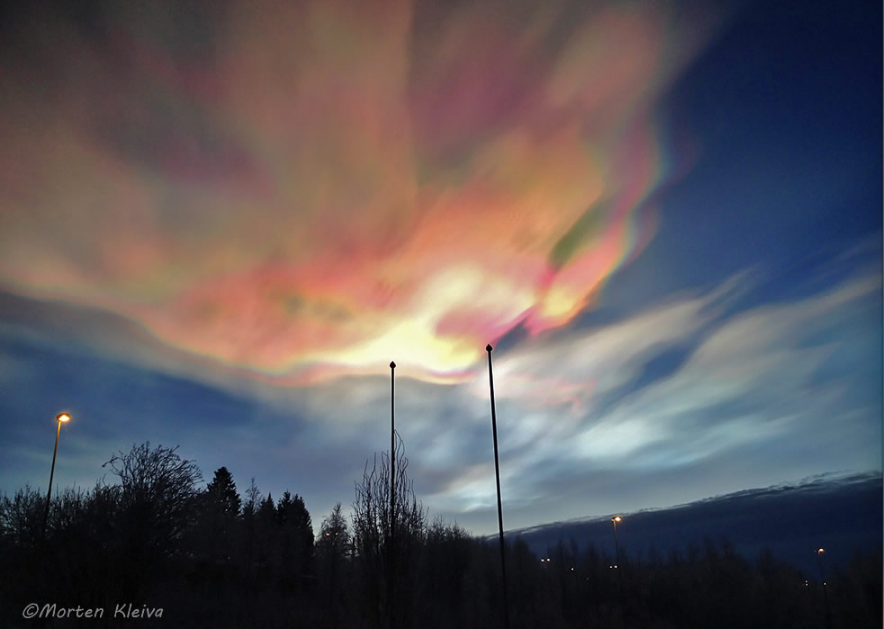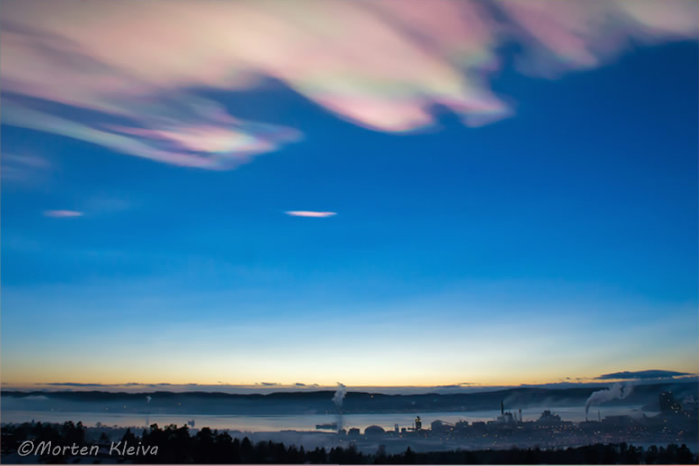Nacreous Clouds, Norway - OPOD
Nacreous Clouds: A Mesmerizing Atmospheric Phenomenon in Norway
Nacreous clouds, also known as polar stratospheric clouds, are a captivating sight that occasionally graces the skies of Norway. These ethereal formations, which appeared in Southern Norway on December 22nd, 2014, have been captured in stunning images and a mesmerizing time-lapse video by photographers Morten Kleiva and Steinar Midtskogen.
The Enigmatic Nature of Nacreous Clouds
Unlike ordinary tropospheric clouds, nacreous clouds reside at an astonishing height of 15 to 25 kilometers in the stratosphere. This lofty altitude places them far above their more common counterparts. To form, nacreous clouds require extremely low stratospheric temperatures, dipping below minus 85 degrees Celsius. As a result, they are primarily observed during winter at high latitudes such as Scandinavia, Iceland, and northern Canada. On rare occasions, however, these captivating clouds may extend slightly further south and even be glimpsed over regions like England. The optimal viewing window for nacreous clouds is after sunset and before sunrise.
The Science Behind Nacreous Clouds
The vivid iridescent colors exhibited by nacreous clouds arise from the diffraction of high-altitude sunlight by minuscule ice crystals composing the cloud. The presence of water necessary for their formation is facilitated by gravity waves induced by mountains and strong tropospheric winds. These atmospheric dynamics lift the required moisture into the stratosphere, creating the ideal conditions for the emergence of nacreous clouds.
Distinguishing Nacreous Clouds from Iridescent Clouds
It is important to differentiate nacreous clouds from their more commonly encountered counterpart, iridescent clouds found in the troposphere. While both types exhibit iridescence, there is no comparison when it comes to the intensity, brightness, and saturation of colors. Nacreous clouds possess a vibrancy that surpasses anything seen in iridescent clouds, making them a truly unique and awe-inspiring spectacle.
Nacreous Clouds: A Full-Day Delight
The allure of nacreous clouds is not confined to the twilight hours. These mesmerizing formations remain visible throughout the brief winter day in Norway. Their presence during daylight adds an extra dimension to their enchanting display, showcasing their iridescent hues against the backdrop of the daytime sky.
Exploring the Wonders of Nacreous Clouds through Time-lapse
To truly appreciate the magnificence of nacreous clouds, Steinar Midtskogen has crafted a captivating time-lapse video. This visual masterpiece allows viewers to witness the gradual evolution of these ethereal formations as they dance across the Norwegian sky. The video showcases the dynamic nature of nacreous clouds, capturing their ever-changing colors and shapes with remarkable detail.
Conclusion
Nacreous clouds represent a captivating atmospheric phenomenon that enchants those fortunate enough to witness their splendor. Found at extreme altitudes in the stratosphere, these ethereal formations create a spectacle of vibrant iridescent colors. Their appearance in Norway during the winter months adds a touch of magic to the already stunning natural landscapes. Through the lens of talented photographers like Morten Kleiva and Steinar Midtskogen, we are granted a glimpse into the enchanting world of nacreous clouds. Whether seen at dawn, dusk, or even during daylight, these captivating formations continue to inspire awe and wonder among all who have the privilege of witnessing their ethereal beauty.

Nacreous Clouds
Southern Norway had vivid nacreous clouds on 22nd December 2014.
Here are images by Morten Kleiva and Steinar Midtskogen . There is also a time lapse video by Steinar.
Nacreous clouds are 15 – 25 km high in the stratosphere, far above ordinary tropospheric clouds. To form they need very low stratospheric temperatures of less than minus 85 Celsius and so are only seen in winter at high latitudes like Scandinavia, Iceland and northern Canada. But, exceptionally, they can occur slightly more south and might – very rarely – be seen over England. Look for them after sunset and before sunrise.
They are composed of very small ice crystals and these diffract the high altitude sunlight to form their vivid iridescent colours. The necessary water is lofted up into stratosphere by gravity waves induced by mountains and high tropospheric winds.

'Ordinary' tropospheric iridescent clouds are often mistaken for stratospheric nacreous. There is actually no comparison for nacreous colours are intense, far brighter and more saturated than those of iridescent clouds.

The clouds were visible before dawn on the 22nd - as here. They were visible again after sunset as in Morten's topmost image.
See the video below for their appearance in daylight.
<iframe width="853" height="480" src="https://www.youtube.com/embed/FH8Q2ezwNlE" title="Nacreous clouds timelapse" frameborder="0" allow="accelerometer; autoplay; clipboard-write; encrypted-media; gyroscope; picture-in-picture; web-share" allowfullscreen></iframe>
A time-lapse video by Steinar Midtskogen.
The clouds remain visible during the brief Norwegian winter day.
Note: this article has been automatically converted from the old site and may not appear as intended. You can find the original article here.
Reference Atmospheric Optics
If you use any of the definitions, information, or data presented on Atmospheric Optics, please copy the link or reference below to properly credit us as the reference source. Thank you!
-
<a href="https://atoptics.co.uk/blog/nacreous-clouds-norway-opod/">Nacreous Clouds, Norway - OPOD</a>
-
"Nacreous Clouds, Norway - OPOD". Atmospheric Optics. Accessed on November 23, 2024. https://atoptics.co.uk/blog/nacreous-clouds-norway-opod/.
-
"Nacreous Clouds, Norway - OPOD". Atmospheric Optics, https://atoptics.co.uk/blog/nacreous-clouds-norway-opod/. Accessed 23 November, 2024
-
Nacreous Clouds, Norway - OPOD. Atmospheric Optics. Retrieved from https://atoptics.co.uk/blog/nacreous-clouds-norway-opod/.